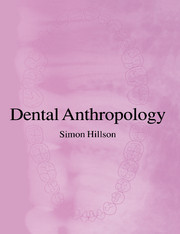Book contents
- Frontmatter
- Contents
- Acknowledgements
- Abbreviations
- 1 Introduction to dental anthropology
- 2 Dental anatomy
- 3 Variation in size and shape of teeth
- 4 Occlusion
- 5 Sequence and timing of dental growth
- 6 Dental enamel
- 7 Dentine
- 8 Dental cement
- 9 Histological methods of age determination
- 10 Biochemistry of dental tissues
- 11 Tooth wear and modification
- 12 Dental disease
- 13 Conclusion: current state, challenges and future developments in dental anthropology
- Appendix A: Field and laboratory methods
- Appendix B: Microscopy
- References
- Index
4 - Occlusion
Published online by Cambridge University Press: 05 June 2012
- Frontmatter
- Contents
- Acknowledgements
- Abbreviations
- 1 Introduction to dental anthropology
- 2 Dental anatomy
- 3 Variation in size and shape of teeth
- 4 Occlusion
- 5 Sequence and timing of dental growth
- 6 Dental enamel
- 7 Dentine
- 8 Dental cement
- 9 Histological methods of age determination
- 10 Biochemistry of dental tissues
- 11 Tooth wear and modification
- 12 Dental disease
- 13 Conclusion: current state, challenges and future developments in dental anthropology
- Appendix A: Field and laboratory methods
- Appendix B: Microscopy
- References
- Index
Summary
Definitions and methodology
Normal occlusion
For a review see Thomson (1990) or Klineberg (1991). Dental occlusion is the way in which teeth fit together, both within and between jaws. Normal occlusion (usually labelled intercuspal or centric occlusion) assumes a young adult with perfect permanent dentition – teeth all regularly and symmetrically arranged – and, although few people actually have dentitions like this, it acts as a standard against which irregularities can be measured. It is the position of the lower teeth within the upper dental arcade that affords maximum contact between the cusps and occlusal grooves of the cheek teeth (Figure 4.1). The incisal edges of upper anterior teeth overlap to labial the incisal edges of lower anterior teeth (a condition known as overbite) and the main cusp of the upper canine fits between the buccal surfaces of the lower canine and first premolar. The cusps of the upper and lower cheek teeth line up into a buccal row and a lingual row, with the buccal cusp row of the lower cheek teeth fitting into the occlusal grooves of the upper cheek teeth, and the lingual cusp row of the upper cheek teeth fitting into the occlusal grooves of the lower teeth. Even with a perfect dentition, this is not necessarily the position held normally or most comfortably, and it is not the position for chewing (which is asymmetrical – see page 244), but it still provides an important reference point.
- Type
- Chapter
- Information
- Dental Anthropology , pp. 106 - 117Publisher: Cambridge University PressPrint publication year: 1996

